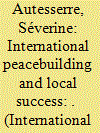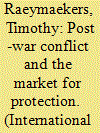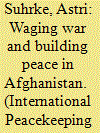|
|
|
Sort Order |
|
|
|
Items / Page
|
|
|
|
|
|
|
| Srl | Item |
| 1 |
ID:
152816


|
|
|
|
|
| Summary/Abstract |
Existing research on war and peace lacks analysis of what allows peacebuilding to succeed at the subnational level. Instead, most scholars focus on peacebuilding failure and macro-level dynamics. This is unfortunate because the obstacles to peacebuilding are such that the most puzzling question is why international efforts sometimes succeed, rather than why they fail. The lack of focus on success is also problematic because it results in ambiguous findings. On the one hand, there is an emerging consensus that local conflict resolution is crucial to building peace. There is also an agreement that, all else being equal, international support tends to increase the chances of successful peacebuilding. On the other hand, when international actors have tried to back local initiatives, they have often generated counterproductive consequences and worsened the situation. Should international actors support local peacebuilding processes? If so, how can they actually do this?
|
|
|
|
|
|
|
|
|
|
|
|
|
|
|
|
| 2 |
ID:
118964


|
|
|
|
|
| Publication |
2013.
|
| Summary/Abstract |
At first glance, Burundi represents a successful negotiated transition to peaceful governance through power sharing, and a justification for regional and international peacebuilders' involvement. It is undeniable that Burundi is safer than it was a decade or two ago. Most notably, while Burundi was once known for its ethnic divisions and antagonism, today ethnicity is no longer the most salient feature around which conflict is generated. Nevertheless, this article argues that the Burundian experience illuminates international peacebuilding contradictions. Peacebuilding in Burundi highlights the complex interplay between outside ideas and interests, and multiple Burundian ideas and interests. This is illustrated by the negotiation and implementation of governance institutions and practices in Burundi. Outsiders promoted governance ideas that were in line with their favoured conception of peacebuilding, and Burundian politicians renegotiated and reinterpreted these institutions and practices. Even as international rhetoric about peacebuilding emphasized liberal governance and inclusive participation, narrower conceptions of peacebuilding as stabilization and control became dominant. Thus, encounters between international, regional, and local actors have produced governance arrangements that are at odds with their liberal and inclusionary rhetorics. Paradoxically, the activities of international peacebuilders have contributed to an 'order' in Burundi where violence, coercion, and militarism remain central.
|
|
|
|
|
|
|
|
|
|
|
|
|
|
|
|
| 3 |
ID:
127078


|
|
|
|
|
| Publication |
2013.
|
| Summary/Abstract |
This article seeks to deepen the debate about violent war-to-peace transitions through a comparative case study between two rebel movements that became integrated in considerably different ways in post-war Democratic Republic of Congo (DRC). The political marketplace brought about by Congo's war-to-peace transition substantially influenced the bargaining power of non-state armed actors in the country's eastern borderlands. In such violent environments, non-state actors like militias, try to become recognized as alternative taxing authorities opposed to state governments, while they simultaneously collaborate with them to gain access to the dividends of international peacebuilding efforts. A decisive factor for the legitimacy of these violent agencies is their ability to transform from coercion- to capital-based organizations: militias, like state governments, need to actively organize local production while embedding their authority in rapidly transforming idioms of political power. This article argues that the 'symbiotic' relationships emerging between rebel rulers, capitalist brokers and state government in the context of protracted armed conflict have far-reaching consequences for the political order of post-war states, with varying results depending on the coercion- and capital-based rule of these emerging complexes in the world's violent peripheries.
|
|
|
|
|
|
|
|
|
|
|
|
|
|
|
|
| 4 |
ID:
108084


|
|
|
|
|
| Publication |
2011.
|
| Summary/Abstract |
Building a harmonious world featuring sustained peace and common prosperity has become a lynchpin of China's international strategy. In order to implement it, the government has developed a series of key operational sub-strategies, including a global peace engagement strategy. The main theme of this approach is that China will strive for peace and promote development by means of peace missions mainly consisting of UN peacekeeping operations (PKOs) and international peacebuilding operations (IPBOs). The article argues that this strategy is based on two cornerstones, peace and development. In practice, China takes different stances towards PKOs and IPBOs: it is a far more cautious contributor in IPBOs, because China's understanding of peacebuilding pays particular attention to development, and Western states are suspicious of China's growing power and intention.
|
|
|
|
|
|
|
|
|
|
|
|
|
|
|
|
| 5 |
ID:
115323


|
|
|
|
|
| Publication |
2012.
|
| Summary/Abstract |
Visions of peace and the means of violence have been strategically joined at the very foundation of the international engagement in Afghanistan since 2001. The two forces have sustained each other - peacebuilding efforts have generated legitimacy and political support for the war - but the violence has also undercut efforts to create structures of peace and prosperity, thus hastening the international search for an exit. The contradictions between simultaneously waging war and building peace in Afghanistan were recognized too late, or not at all, in international peacebuilding circles. During the early phase of the intervention, in particular, the aid and rights communities were vocal advocates for a strong international military presence. The discourse on 'security' as a prerequisite for development and peace has continued to mask the underlying tensions in the security-peacebuilding nexus as they appear in Afghanistan's internationalized civil war.
|
|
|
|
|
|
|
|
|
|
|
|
|
|
|
|
|
|
|
|
|